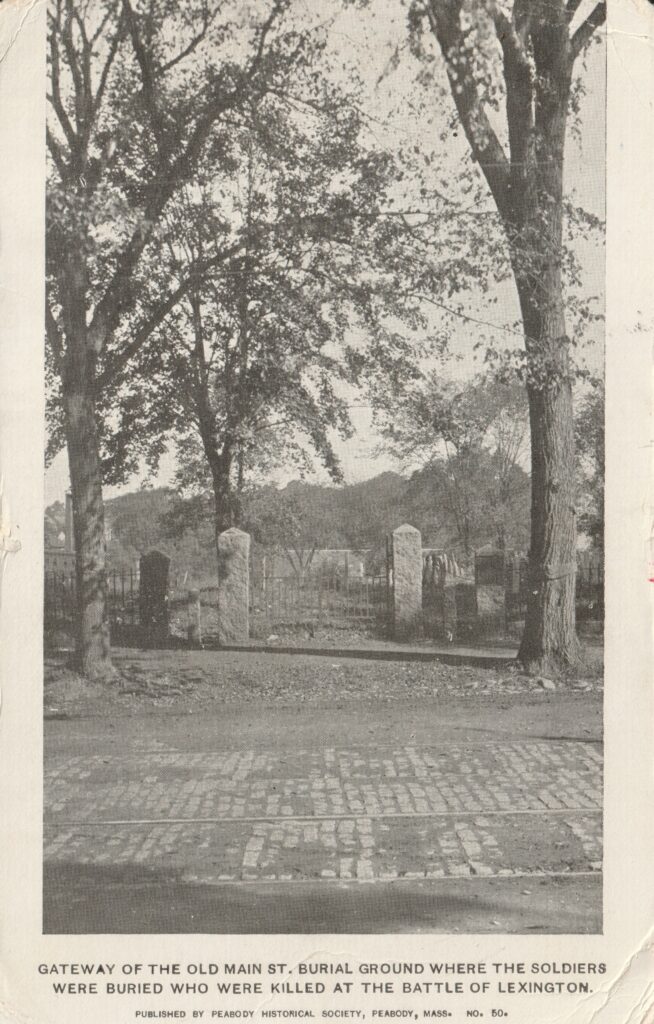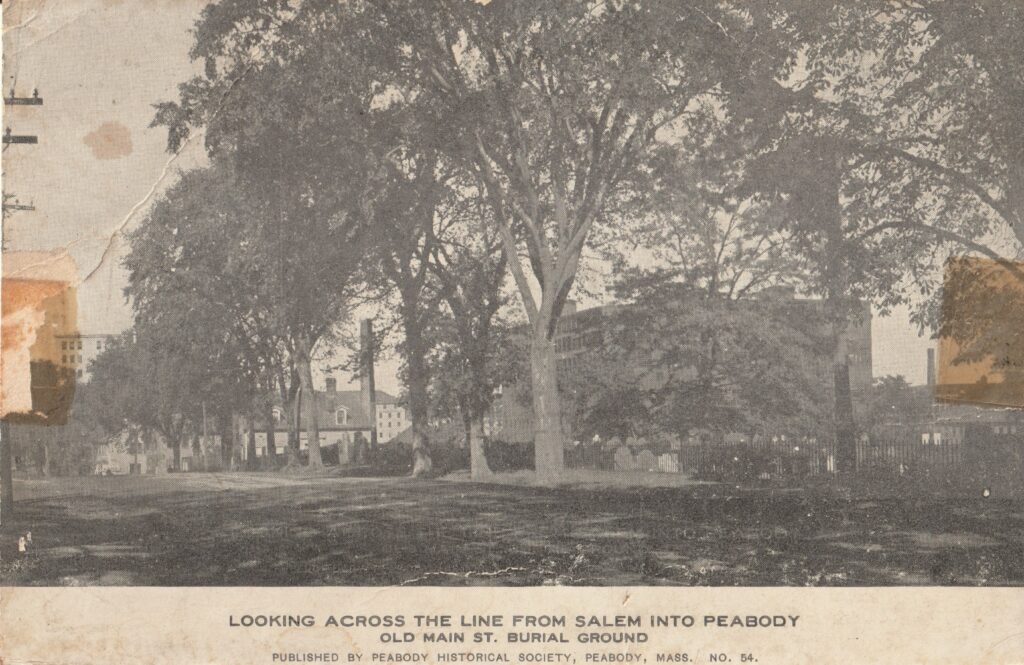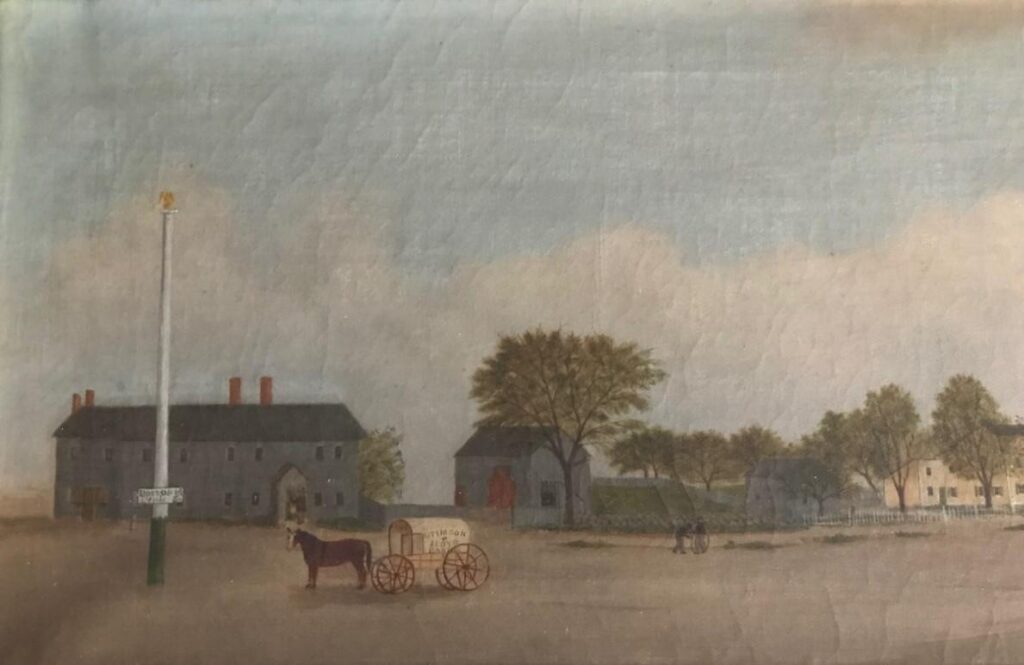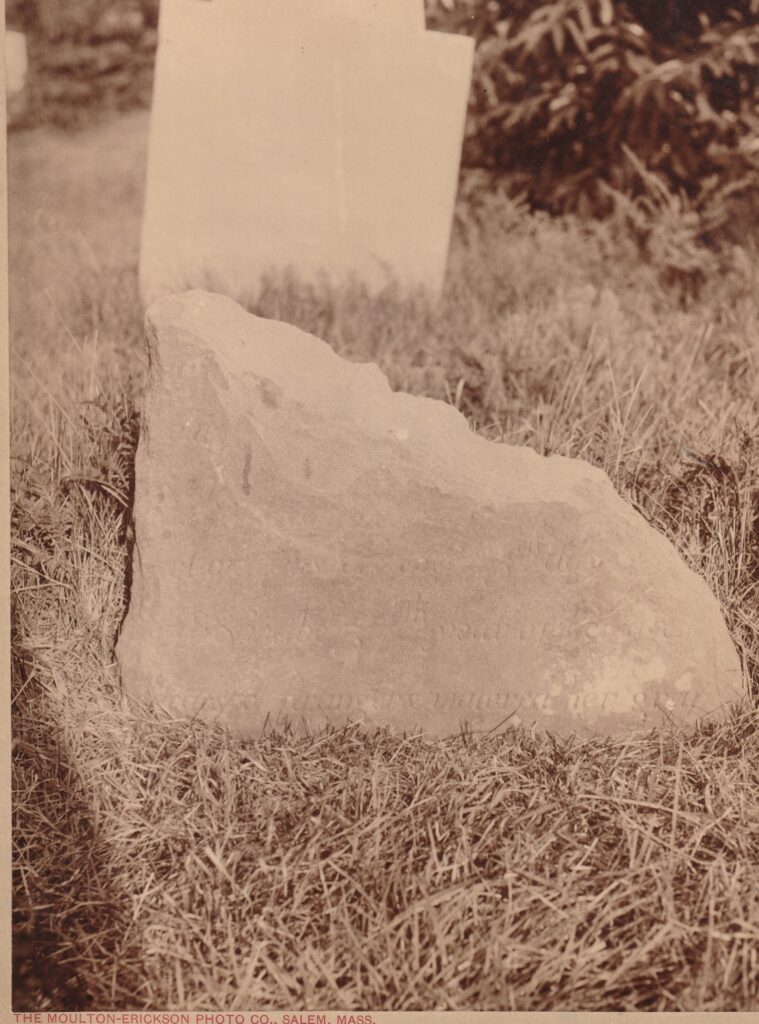
Postcard, 1905
The Old South Burying Ground has been known by several names in its history: Boston Street Burying Ground, Old Burying Ground, South Burying Ground, Danvers Ground, Main Street Cemetery and the Trask Burying Ground. The land can be traced back to one of the original English settlers in Salem, Captain William Trask. Trask emigrated in 1628 and established the first milling operation and glasshouse in the area. The cemetery land was given to the Town by William Trask’s descendent, Lydia Trask, around 1750.
The oldest headstone in the cemetery dates to 1689, belonging to Lucreatia Derby (1643-1689). Her husband Roger Derby was also buried here in 1698.

Postcard, 1905
When the main road was widened in the early nineteenth century, a fence was placed around the burial ground. As a consequence, four of the seven South Danvers men who sacrificed their lives at the Battle of Lexington are now believed buried beneath the sidewalk or the roadway, following later construction. In 1896, the Peabody Historical Society placed a bronze plaque to commemorate their lives Later, the City Veterans Agent arranged special recognition of the four by obtaining the white veteran grave markers now in place.

“Eagle Corner and Washington Street” by Charles Dole; Detail of Painting, 1828, of Washington and (now) Main Streets; From the Collection of the Peabody Historical Society & Museum
This was the location that the Peabody soldiers met before marching to the Battle of Lexington and Concord.
American Revolutionary War
Samuel Cook, Jr. (1742-1775), died at the Battle of Menotomy, April 19, 1775
Benjamin Daland, Jr. (1750-1775), died at the Battle of Menotomy, April 19, 1775
Ebenezer Goldthwait (1753-1775), died at the Battle of Menotomy, April 19, 1775
George Southwick, Jr. (1750-1775), died at the Battle of Menotomy, April 19, 1775
Captain Dennison Wallis (1756-1825), injured on April 19, 1775 at the Battle of Menotomy
Major Caleb Low (1740-1810), Captain of company that marched on the alarm on April 19, 1775, served under Col. Henry Herrick’s 8th Essex Co., Captain Jeremiah Putnam’s Co., Col. Nathaniel Wade’s Regiment
First Lieutenant Benjamin Jacobs (1741-1814), Captain Samuel Epes’s Co., Col. Pickering’s Regiment, marched on the alarm of April 19, 1775, served under Captain Caleb Low’s 3rd Company, Co, Col. Henry Herrick’s 8th Essex Co., Col. Nathaniel Wade’s Regiment
Captain Ebenezer Sprague, Jr. (1760-1855), Captain Caleb Low’s Co, marched on the alarm on April 19, 1775
Robert Shillaber (1736-1808), Private, Captain Caleb Low’s Co, marched on the alarm on April 19, 1775
David Felton (1757-1818), Private, Captain Jeremiah Page’s Co.
Jacob Reed (1754-1825), Private, Poor’s New Hampshire Regiment
William Southwick (1753-1828), Private, Captain Samuel Epes Co.
Samuel Peabody (1757-1839), Private, Captain Stephen Websters’ Co., Col. Jacob Gerrish Regiment
Captain Silas Smith (1730-1806), commander of the schooner Fly, 1780
War of 1812: William Southwick, Jr. (1787-1825)
Civil War: George H. Shove III (1838-1877)
Mariners:
- Captain John Tucker (1743-1788)
- Captain Jonathan Tucker (1746-1791)
- Captain William Smith (1766-1792)
- Capt. Samuel White, lost at sea (1763-1800)
- Captain Daniel Frye (1756-1813)
- Captain John Frost (1786-1880)
- Captain Benjamin Shillaber (1758-1823)
- Captain Henry Saunders (1771-1835)
- Captain Nathaniel Garland (unknown)
- Captain Jones Very (1790-1824)
Another notable person buried here was Elizabeth Whitman (1752-1788). Whitman traveled to the Bell Tavern in Danvers, in 1788. She was a mysterious figure who died as a result of giving birth, shortly after her arrival. Her place in history was cemented when author Hannah Webster Foster fictionalized her tale in the novel The Coquette or, The History of Eliza Wharton, published in 1797. Foster wrote the popular piece, changing Whitman’s name to Eliza Wharton, telling her story in the manner of a cautionary tale to young women about the dangers of following your heart. Hannah Webster Foster is considered one of the first published, female romance novelists in the United States. Her grave had become a tourist attraction, leading some to chip pieces off her gravestone as souvenirs. The Peabody Historical Commission erected a new headstone, in 2004, beside the original.

Original Gravestone for Elizabeth Whitman, circa 1900
Also buried here is Reverend Nathan Holt, Pastor of “2nd Church in Danvers” (South Parish Church), the second Pastor of the Church, serving for 34 years, including the years of the Revolution. He may have officiated over internment of the four men at South Burying Ground.
